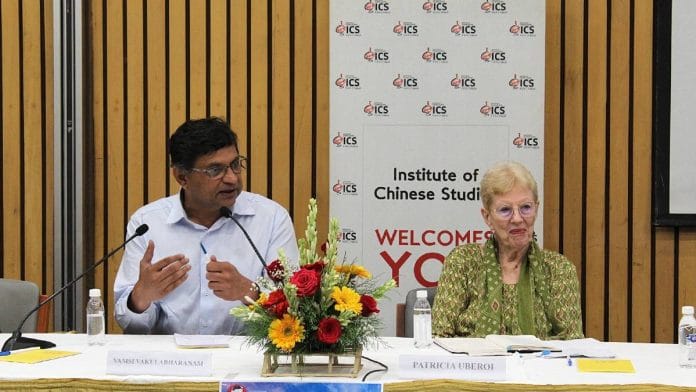New Delhi: When economist Vamsi Vakulabharanam asked a professor in China about social class inequalities in the nation, he was told “there are no classes in China”.
He then spent a month in the nation with the professor, and with empirical observation, highlighted to him the class inequalities there.
Vakulabharanam’s work on the subject, Class and Inequality in China and India, 1950-2010, was published in November 2024. It delves deep into the complex and shifting terrain of class and inequality in India and China, and is the first political economy framework that is unified in thinking about the two nations.
It was this work that was the focus of the 17th Giri Deshingkar Memorial Lecture, held jointly by the Centre for the Study of Developing Societies (CSDS) and the Institute of Chinese Studies (ICS) in New Delhi Tuesday.
The event featured prominent academicians, including former chairperson of ICS and sociologist Patricia Uberoi, professor Alka Acharya, honorary director of ICS, and professor Awadhendra Sharan, director of CSDS.
Drawing on his work, Vakulabharanam in a talk titled ‘Class and Inequality in China and India in Historical Perspective: Implications in a Changing World Order’ argued that class has been the most significant driver of inequality in both countries from 1950 to 2010. He said his work focused on data up to 2010 because post-2011 data released in India was not very “reliable”.
India, China and inequality
In a cross-national comparison of inequality in India and China, Vakulabharanam found that despite their differing political systems—China’s socialism versus India’s mixed capitalism —the two nations shared strikingly similar inequality trajectories, particularly after adopting market reforms.
Both underwent “inequality earthquakes”, with elites and professionals emerging as the main beneficiaries of economic liberalisation.
So, while aggregate growth figures may dominate headlines, the class dynamics and unequal distribution of wealth and opportunity continue to shape the lived realities of billions in both countries, he said.
He posited that inequality declined in the early decades, during India’s planned economy phase and China’s Maoist reforms, but surged again after liberalisation in the 1980s and 1990s.
In India, inequality fell from the 1950s to the early 1980s, yet poverty levels remained high, hovering around 40 percent. Vakulabharanam described this as “top-to-middle redistribution”, where resources moved from elites to middle classes rather than to the poorest.
In contrast, China’s early socialist policies, including land reforms, collectivisation, and investments in health and education, achieved broader redistribution, though data from the Mao-era (1949 to 1976) remains limited, he said.
The liberalisation era marked a sharp divergence. Between 1988 and 2007, China’s Gini coefficient—a measure of inequality—rose by 20 percent, following the retrenchment of 50 million workers and sweeping neoliberal reforms. Inequality in India also rose steeply between 1991 and 2005, with the Gini coefficient for consumption increasing by over 10 percent. Urban elites and professionals emerged as the main beneficiaries in both nations, he said.
“In India, inequality declined until the 1980s but poverty levels stagnated. This suggests that the middle classes gained while the poor remained largely excluded from growth,” Vakulabharanam asserted.
In both India and China, growth in inequality slowed somewhat in the mid-2000s. In India, the introduction of welfare programmes like the National Rural Employment Guarantee Scheme contributed to this.
Vakulabharanam challenged the widely accepted Kuznets Curve, which posits that income inequality rises in early economic development and later declines. He added that during this time, formal-sector owners, top managers, and white-collar professionals experienced the highest gains, while farmers, informal workers, and rural labourers saw minimal improvement.
According to Vakulabharanam, despite different political systems, India and China have followed remarkably parallel paths. “The dominant class coalitions of urban capitalists and professionals now shape the relationship with the state,” he said.
As the lecture concluded, Vakulabharanam proposed that the India-China comparison could offer a template for studying inequality globally. “The lessons are not just regional,” he said. “They offer a framework to understand inequality in any country where class dynamics intersect with state policy.”
ThePrint is a digital partner for the event.






